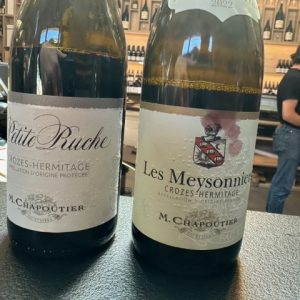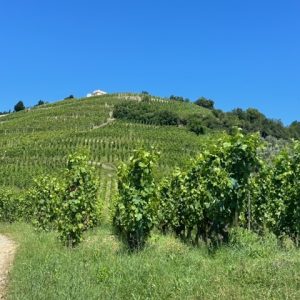Hermitage Hill
Hermitage Hill is such a beautiful spot that I just made a return visit. The first time, I walked up the face of the Hill. This time I walked around the Hill in a southerly direction.
It got its name from a “hermit” who lived there at one time. Maybe that is part of the attraction.
Along my walk, I met with some workers who were pruning the vines. They were a motley bunch of multiple ethnicities. So I fitted in well.
They were pessimistic about this year’s vintage. The vines are suffering from mildew.
This is the moment to address a critical issue for all Rhone wine lovers – Hermitage versus Crozes-Hermitage wines. In short, Hermitage comes out on top!
Hermitage AOC is actually one of France’s oldest wine appellations, with a rich heritage that dates back to Roman times. Along with Côte-rôtie, further north up the Rhone, Hermitage is among the best of the northern Rhone appellations,
Grapes for Hermitage are grown on a mere 130 hectares up the south-west side of Hermitage Hill, a steep granite hill, which overlooks the town of Tain-l’Hermitage on the east side of the Rhone river.
The grapes have very good exposure to sunlight and are well protected from the cold and gusty Mistral wind that is a hallmark of the Rhone Valley. The steep granite hill, with lots of old vines, are ideal conditions for producing wines of remarkable intensity, high tannins and the ability to age in bottle for decades.
Hermitage red wines are made from the Syrah grape variety (known as Shiraz in Australia), although it is permitted to add up to 15% Marsanne and/or Roussanne grapes. Yes, juice from the white grapes can be added to the red Hermitage wine.
At the same time, there is a small production of wonderful Hermitage white wines, which tend to be Marsanne-dominant, with Roussanne being added as a blending partner.
Crozes-Hermitage, the largest appellation in the Northern Rhone, is a different beast. It covers a much larger territory, over 1,700 hectares, essentially surrounding the Hermitage vineyards to the north, south and east. On the west side is the Rhone River!
It features a diverse terroir with a range of soils which are generally speaking more fertile than the soils in Hermitage. The topography consists of both gentle and steep rolling hills in the north and flatter land in the south. Crozes-Hermitage grapes are machine-picked, whereas those for Hermitage are hand-picked.
The Crozes-Hermitage grapes also enjoy a diverse climate – markedly cooler in the north and with more exposure to the Mistral wind and more temperate in the south. This means that the wine styles can vary significantly. Crozes-Hermitage is also based on the Syrah grape variety, with small amounts of Marsanne and Roussanne.
The resulting red wines from Crozes-Hermitage tend to be lighter in body and exhibit less tannic structure compared to Hermitage wines, more often displaying fresh and vibrant fruit flavors. The white wines also tend to be lighter in body and fresher in style.
Wines are typically not aged for long periods of time in new oak barrels. As a result, the wines of this appellation are often suitable for early consumption and do not require (or benefit from) long periods of bottle aging in your cellar.
The three most important producers of Hermitage are Chave, Jaboulet and Chapoutier.
Chave is the greatest producer in Hermitage. The family has been making wine there since the 1400s. Paul Jaboulet Ainé is not nearly as old as the Chave family, but they have been producing Northern Rhone wines for nearly 200 years. Chapoutier is a little older than Jaboulet, with roots in an important old Bordeaux house,





